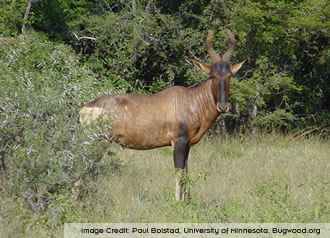Alcelaphinae (bonteboks, hartebeest, wildebeest)
The animals in this subfamily are all nomadic antelopes found in Africa. They have long legs and long faces and both the males and females have horns. They are grazers and live in herds. This subfamily contains 10 species of bonteboks, hartebeests, wildebeests,and related animals in four genera. |
|
 |
World Status Key
 Least Concern Least Concern  Near Threatened Near Threatened  Vulnerable Vulnerable  Endangered Endangered  Critically Endangered Critically Endangered  Extinct in the Wild Extinct in the Wild  Extinct Extinct
Status and range is taken from ICUN Redlist. If no status is listed, there is not enough data to establish status.
US Status Key
 Threatened in US Threatened in US  Threatened in NH Threatened in NH  Endangered in US Endangered in US  Endangered in NH Endangered in NH  Breeds in NH Breeds in NH  Introduced Introduced
Status taken from US Fish and Wildlife and NH Fish and Game
New Hampshire Species |
|
North/Central American Species |
None
|
|
None |
Additional Information
Key:  Profile Profile  Photos Photos  Video Video  Audio Audio
Hartebeest - Alcelaphus buselaphus     
The hartebeest may look clumsy, but it is a very nimble runner!
Source: Arkive Intended Audience: General Reading Level: Middle School
Hartebeest - Alcelaphus buselaphus    
Hartebeests are found in medium and tall grasslands, including savannas.
Source: African Wildlife Foundation Intended Audience: General Reading Level: Middle School
Hartebeest - Alcelaphus buselaphus    
Hartebeests feed almost entirely on grass.
Source: Animal Diversity Web Intended Audience: General Reading Level: Middle/High School
Hirola - Beatragus hunteri    
The hirola is also known as the four-eyed antelope because it has scent glands under its eyes that expands when it is excited.
Source: Arkive Intended Audience: General Reading Level: Middle School
Hirola - Beatragus hunteri    
It is estimated that there are only 600 hirola today. The surviving hirola are threatened by drought, poaching and habitat loss. They are currently found on south-eastern coast of Kenya, just south of the border with Somalia.
Source: EDGE Intended Audience: General Reading Level: Middle School
Hirola - Beatragus hunteri   
Hirola have long legs, a long body, and a long face. Both the male and female hirola have horns.
Source: Animal Diversity Web Intended Audience: General Reading Level: Middle/High School
Black Wildebeest - Connochaetes gnou    
Black wildebeests are also known as white-tailed gnus. Source: Animal Diversity Web Intended Audience: General Reading Level: Middle/High School
Blue Wildebeest - Connochaetes taurinus    
When wildebeest travel, they walk with their heads down. Source: Animal Diversity Web Intended Audience: General Reading Level: Middle/High School
Blue Wildebeest - Connochaetes taurinus     
When they migrate, blue wildebeest form large herds. Source: Arkive Intended Audience: General Reading Level: Middle School
Bontebok - Damaliscus pygargus     
The bontebok is also known as the blesbok. During the hottest part of the day, bonteboks often stand in groups facing the sun and nodding tier heads.
Source: Arkive Intended Audience: General Reading Level: Middle School
Bontebok - Damaliscus pygargus    
This grazing animal is found in South Africa.
Source: Animal Diversity Web Intended Audience: General Reading Level: Middle School
Topi - Damaliscus lunatus    
Male topi leave their mother when they are about a year old to join a bachelor herd.
Source: Animal Diversity Web Intended Audience: General Reading Level: Middle/High School
Topi - Damaliscus lunatus     
Topi will stand on termite mounds to watch for danger. Source: Arkive Intended Audience: General Reading Level: Middle School
|

